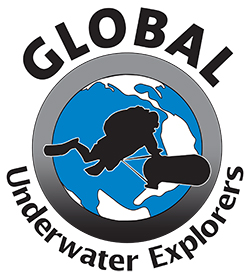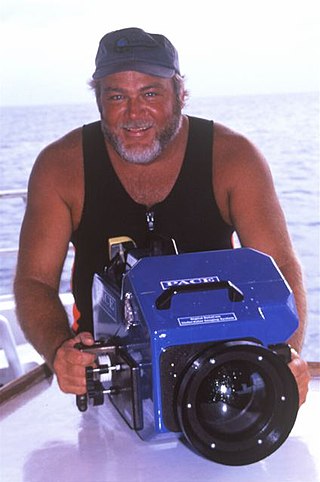
Technical diving is scuba diving that exceeds the agency-specified limits of recreational diving for non-professional purposes. Technical diving may expose the diver to hazards beyond those normally associated with recreational diving, and to a greater risk of serious injury or death. Risk may be reduced via appropriate skills, knowledge, and experience. Risk can also be managed by using suitable equipment and procedures. The skills may be developed through specialized training and experience. The equipment involves breathing gases other than air or standard nitrox mixtures, and multiple gas sources.

Cave-diving is underwater diving in water-filled caves. It may be done as an extreme sport, a way of exploring flooded caves for scientific investigation, or for the search for and recovery of divers or, as in the 2018 Thai cave rescue, other cave users. The equipment used varies depending on the circumstances, and ranges from breath hold to surface supplied, but almost all cave-diving is done using scuba equipment, often in specialised configurations with redundancies such as sidemount or backmounted twinset. Recreational cave-diving is generally considered to be a type of technical diving due to the lack of a free surface during large parts of the dive, and often involves planned decompression stops. A distinction is made by recreational diver training agencies between cave-diving and cavern-diving, where cavern diving is deemed to be diving in those parts of a cave where the exit to open water can be seen by natural light. An arbitrary distance limit to the open water surface may also be specified.
The International Scuba Diving Hall of Fame (ISDHF) is an annual event that recognizes those who have contributed to the success and growth of recreational scuba diving in dive travel, entertainment, art, equipment design and development, education, exploration and adventure. It was founded in 2000 by the Cayman Islands Ministry of Tourism. Currently, it exists virtually with plans for a physical facility to be built at a future time.
The World Recreational Scuba Training Council (WRSTC) was founded in 1999 and is dedicated to creating minimum recreational diving training standards for the various scuba diving certification agencies across the world. The WRSTC restricts its membership to national or regional councils. These councils consist of individual training organizations who collectively represent at least 50% of the annual diver certifications in the member council's country or region. A national council is referred to as a RSTC.

The European Underwater Federation (EUF) is an umbrella organisation representing the interests of scuba diver training organisations operating in both the not for profit and for profit sectors within Europe.

Global Underwater Explorers (GUE) is a scuba diving organization that provides education within recreational, technical, and cave diving. It is a nonprofit membership organization based in High Springs, Florida, United States.

Tom Mount was an American pioneering cave diver and technical diver.

Richard Rutkowski is a pioneer in the fields of hyperbaric medicine, diving medicine and diver training, especially in relation to the use of breathing gases.
Steve Lewis is an active cave and wreck diver. Born in Peckham, New Cross London, he currently resides in Muskoka, Ontario Canada.

Bret Clifton Gilliam was an American pioneering technical diver. He was most famous as co-founder of the certification agency Technical Diving International along with Mitch Skaggs, and as the one time holder of the world record for deep diving on air. He is also one of diving's most popular writers. Gilliam is the author or coauthor of 72 books, over 1500 feature magazine articles, and over 100 magazine cover photos. In his diving career he has logged over 19,000 dives(NOT VERIFIED) since 1959.
Jarrod Michael Jablonski is a pioneering technical diver and record setting cave diver as well as an accomplished business owner and operator. These business operations include Halcyon Manufacturing, Extreme Exposure Adventure Center and Global Underwater Explorers. In July 2021 Jablonski launched and now operates the world's deepest pool at Deep Dive Dubai. Jablonski is one of the main architects behind the 'Doing It Right' system of diving.

Agnes Milowka was an Australian technical diver, underwater photographer, author, maritime archaeologist and cave explorer. She gained international recognition for penetrating deeper than previous explorers into cave systems across Australia and Florida, and as a public speaker and author on the subjects of diving and maritime archaeology. She died aged 29 while diving in a confined space.

Neal Pollock is a Canadian academic and diver. Born in Edmonton, Canada he completed a bachelor's degree in zoology; the first three years at University of Alberta and the final year at the University of British Columbia. After completing a master's degree he then served as diving officer at University of British Columbia for almost five years. He then moved to Florida and completed a doctorate in exercise physiology/environmental physiology at Florida State University.
The NOGI Awards is an award presented annually by the Academy of Underwater Arts and Sciences (AUAS) to diving luminaries and is "considered the Oscar of the ocean world." Selection of recipients is based on their record of accomplishments and excellence in the diving world. NOGI awards are given out to world-class standouts of the diving community who have distinguished themselves and made a global impact on diving in one or more of four general categories: Science, Arts, Sports/Education, and Environment. A fifth NOGI is given for Distinguished Service.
Edd Sorenson is a technical cave diver known for numerous rescues of lost or trapped divers in the underwater caves of Florida, particularly in Vortex Spring and Blue Spring State Park. He is well known for being one of the most experienced cave divers in the world.

On August 20, 2010, Ben McDaniel, of Memphis, Tennessee, United States, was reported missing after employees in the dive shop at Vortex Spring, north of Ponce de Leon, Florida, noticed that his pickup truck had remained in the shop's parking lot for the previous two days. McDaniel, who had been diving regularly at the spring while living in his parents' nearby beach house, had last been seen by two of those employees on the evening of August 18, on a dive entering a cave 58 feet (18 m) below the water's surface. While he was initially believed to have drowned on that dive, and his parents still strongly believe his body is in an inaccessible reach of the extensive cave system, no trace of him has ever been found. The state of Florida issued his family a death certificate in 2013.

Richard William Stanton, is a British civilian cave diver who specialises in rescues through the Cave Rescue Organisation and the British Cave Rescue Council. He has been called "one of the world's most accomplished cave-divers", "the face of British cave diving," and "the best cave diver in Europe". Stanton has lived in Coventry for many years, and was formerly a firefighter with the West Midlands Fire Service for 25 years prior to his retirement. In 2018 he played a leading role in the Tham Luang cave rescue and was awarded the George Medal in the Civilian Gallantry List.

This is a list of underwater divers whose exploits have made them notable. Underwater divers are people who take part in underwater diving activities – Underwater diving is practiced as part of an occupation, or for recreation, where the practitioner submerges below the surface of the water or other liquid for a period which may range between seconds to order of a day at a time, either exposed to the ambient pressure or isolated by a pressure resistant suit, to interact with the underwater environment for pleasure, competitive sport, or as a means to reach a work site for profit or in the pursuit of knowledge, and may use no equipment at all, or a wide range of equipment which may include breathing apparatus, environmental protective clothing, aids to vision, communication, propulsion, maneuverability, buoyancy and safety equipment, and tools for the task at hand.
Basic Cave Diving: A Blueprint for Survival, also commonly referred to by the subtitle alone, A Blueprint for Survival, is a short book on safe scuba diving procedures for cave diving by pioneer cave diver Sheck Exley, originally published in 1979, by the Cave Diving Section of the National Speleological Society. It is considered to have had a significant impact on the number of cave diving fatalities since publication, and is considered one of the more historically important publications in recreational diving.

Cave diving is underwater diving in water-filled caves. The equipment used varies depending on the circumstances, and ranges from breath hold to surface supplied, but almost all cave diving is done using scuba equipment, often in specialised configurations with redundancies such as sidemount or backmounted twinset. Recreational cave diving is generally considered to be a type of technical diving due to the lack of a free surface during large parts of the dive, and often involves planned decompression stops. A distinction is made by recreational diver training agencies between cave diving and cavern diving, where cavern diving is deemed to be diving in those parts of a cave where the exit to open water can be seen by natural light. An arbitrary distance limit to the open water surface may also be specified. Despite the risks, water-filled caves attract scuba divers, cavers, and speleologists due to their often unexplored nature, and present divers with a technical diving challenge.












